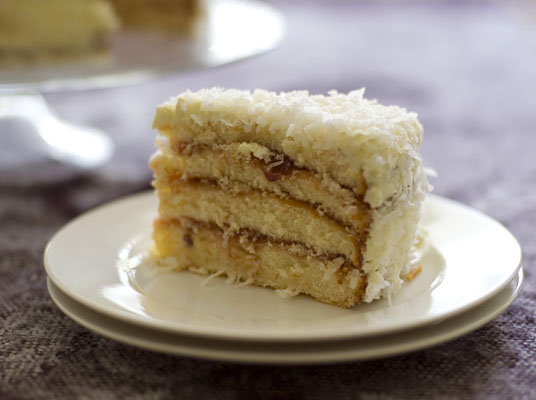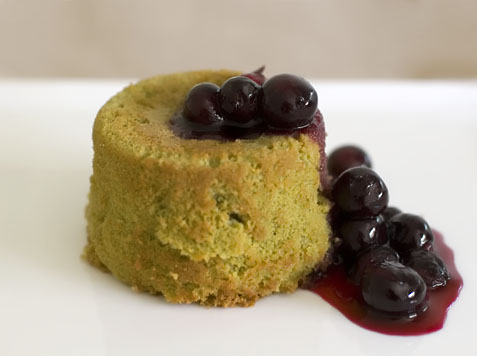Raspberry, Coconut and Russell Crowe
Apparently ‘buttercream’ sounds like ‘Russell Crowe’. That’s how he heard it anyway, when he asked me one morning about the type of cake I was making. “Raspberry, coconut and buttercream”, I mumbled, half asleep, face pressed deeply into my pillow. He got the bit about raspberry and coconut, but was rather stumped as to what Russell Crowe had anything to do with it.
So anyway, not only are we rather lacking in the Russell Crowe department, but I’m forced to confess that I didn’t have the necessary raspberry jam either. I only realised this when it came time to assemble the cake, and resorted to what jams I did have lying around instead : a quince marmalade from Lynwood Cafe and a Fortnum & Mason rosepetal jam (which by the way travelled with me all the way back from London, and was so delicious that I was consuming it in small amounts to make it last longer).
In the absence of quite a few original key components (this includes Russell Crowe), what DOES this cake have going for it, in the end? Well, for starters, the coconut’s still there! But really, this cake is a dream. I love the closed crumb and the flavour that is buttery like a madeira cake, but with a texture as light as a sponge. Coming from someone who doesn’t normally like buttercream, this lemon flavoured buttercream was genius, I thought. The best I’d ever tasted. The amount of lemon was just right, allowing the acidity to cut the sweetness and richness of the buttercream, giving it a certain airy lemon curdy presence, without resorting to being a lemon curd, which might have been too full on for this delicate cake. The verdict? An absolutely gorgeous and incredibly easy to prepare party piece. One I hope to make again in the near future.
Thanks Morven for picking such a great recipe for us to play with this month! Now I wonder if anyone else managed to find Russell Crowe for their cake…
Perfect Party Cake :
(Recipe from Dorie Greenspan’s Baking from My Home to Yours)
For the Cake
2 ½ cups cake flour
1 tablespoon baking powder
½ teaspoon salt
1 ¼ cups whole milk or buttermilk
4 large egg whites
1 ½ cups sugar
2 teaspoons grated lemon zest
113g unsalted butter, at room temperature
½ teaspoon pure lemon extract
For the Buttercream
1 cup sugar
4 large egg whites
340g unsalted butter, at room temperature
¼ cup fresh lemon juice (from 2 large lemons)
1 teaspoon pure vanilla extract
For Finishing
2/3 cup seedless raspberry preserves stirred vigorously or warmed gently until spreadable
About 1 ½ cups sweetened shredded coconut
Getting Ready
Centre a rack in the oven and preheat the oven to 175’C. Butter two 9 x 2 inch round cake pans and line the bottom of each pan with a round of buttered parchment or wax paper. Put the pans on a baking sheet.
To Make the Cake
Sift together the flour, baking powder and salt.
Whisk together the milk and egg whites in a medium bowl.
Put the sugar and lemon zest in a mixer bowl or another large bowl and rub them together with your fingers until the sugar is moist and fragrant.
Add the butter and working with the paddle or whisk attachment, or with a hand mixer, beat at medium speed for a full 3 minutes, until the butter and sugar are very light.
Beat in the extract, then add one third of the flour mixture, still beating on medium speed.
Beat in half of the milk-egg mixture, then beat in half of the remaining dry ingredients until incorporated.
Add the rest of the milk and eggs beating until the batter is homogeneous, then add the last of the dry ingredients.
Finally, give the batter a good 2- minute beating to ensure that it is thoroughly mixed and well aerated.
Divide the batter between the two pans and smooth the tops with a rubber spatula.
Bake for 30-35 minutes, or until the cakes are well risen and springy to the touch – a thin knife inserted into the centers should come out clean
Transfer the cakes to cooling racks and cool for about 5 minutes, then run a knife around the sides of the cakes, unfold them and peel off the paper liners.
Invert and cool to room temperature, right side up (the cooled cake layers can be wrapped airtight and stored at room temperature overnight or frozen for up to two months).
To Make the Buttercream
Put the sugar and egg whites in a mixer bowl or another large heatproof bowl, fit the bowl over a plan of simmering water and whisk constantly, keeping the mixture over the heat, until it feels hot to the touch, about 3 minutes.
The sugar should be dissolved, and the mixture will look like shiny marshmallow cream.
Remove the bowl from the heat.
Working with the whisk attachment or with a hand mixer, beat the meringue on medium speed until it is cool, about 5 minutes.
Switch to the paddle attachment if you have one, and add the butter a stick at a time, beating until smooth.
Once all the butter is in, beat in the buttercream on medium-high speed until it is thick and very smooth, 6-10 minutes.
During this time the buttercream may curdle or separate – just keep beating and it will come together again.
On medium speed, gradually beat in the lemon juice, waiting until each addition is absorbed before adding more, and then the vanilla.
You should have a shiny smooth, velvety, pristine white buttercream. Press a piece of plastic against the surface of the buttercream and set aside briefly.
To Assemble the Cake
Using a sharp serrated knife and a gentle sawing motion, slice each layer horizontally in half.
Put one layer cut side up on a cardboard cake round or a cake plate protected by strips of wax or parchment paper.
Spread it with one third of the preserves.
Cover the jam evenly with about one quarter of the buttercream.
Top with another layer, spread with preserves and buttercream and then do the same with a third layer (you’ll have used all the jam and have buttercream leftover).
Place the last layer cut side down on top of the cake and use the remaining buttercream to frost the sides and top.
Press the coconut into the frosting, patting it gently all over the sides and top.
[Note: I only used jam between the layers, as the boy is lactose intolerant. The buttercream I used to ice the outside of the cake only, so he had the option of scraping it off]






